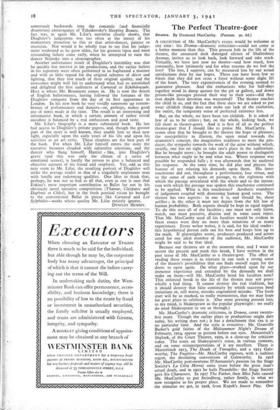Diaghilev and the Ballet
Diaghilev. By Serge Lifar. (Putnam. ns.) The Diaghilev Ballet in London. By Cyril W. Beaumont. (Putnam. los. 6d.) THERE is no denying the importance of Serge Diaghilev. For during the two decades that preceded his death in 1929 no one exercised a greater influence upon the arts of music and painting, and especially upon these arts as applied to the theatre. Whether that influence was, on the balance, good or bad is a matter for debate. Diaghilev, coming into the theatre as an amateur of painting and of music, never lost the dilettante's impatience to pass on to the next thing, never acquired the stability of the true artist who has found his métier and sticks to it. Diaghilev had a positively Athenian passion for something new. If it is not quite true to say that he turned to the theatre because he had exhausted th.t pleasures of connoisseurship in painting—if one may apply the term to what seems to have been no more than taste informed by a natural sensibility—the change of interest was certainly not unwelcome. And, as Mr. Lifar shows, he was rapidly losing his interest in the ballet during the last year of his life, not merely because he was losing a grip on things generally, but because he had found a new interest in the collection of books.
This restlessness and instability of purpose produced some strange results. The Russian Ballet, under Diaghilev's direction, certainly never stood still in one place for long at a time. But instead of progressing in one direction and producing a sense of steady development, it was apt to jump disconcertingly into modernistic extravagance of La Chatte or, even more surprisingly,
somersault backwards into the romantic (and financially disastrous) extravagance of Tchaikovsky's Sleeping Beauty. The fact was, as again Mr. Lifar's narrative clearly shows, that Diaghilev's judgement was too often at the mercy of his momentary attraction to this or that artist-dancer, painter or musician. Nor would it be wholly true to say that his judge- ment weakened as he grew older, for his greatest lapse and most resounding failure came early, when he attempted to turn the dancer Nijinsky into a choreographer.
Another unfortunate result of Diaghilev's instability was that he quickly lost interest in his productions, and the earlier ballets in his repertory were often performed in so haphazard a manner and with so little regard for the original schemes of decor and lighting, that they lost much of their original quality, and the newcomer might well fail to understand what had so astonished and delighted the first audiences of Carnaval or Scheherazade. Here is where Mr. Beaumont comes in. He is now the doyen of English balletomanes, having followed the fortunes of the Diaghilev company from the day of its first appearance in London. In his new book he very vividly summons up remem- brance of performances and dancers—or, perhaps, makes good use of notes made at the time. The result is an interesting and informative book, in which a certain amount of rather trivial anecdote is balanced by a real enthusiasm and good taste.
Mr. Lifar's biography is a more substantial. book. He has had access to Diaghilev's private papers, and, though the greater part of the story is well known, they enable him to shed new light, especially upon the early years of his life and upon his activities as an art critic. These chapters are the best part of the book. For when Mr. Lifar himself enters the story the narrative becomes clouded with subjective emotions, and the dancer who flung himself, Hamlet - like, into Diaghilev's grave (and this was only the climax of a series of emotional scenes), is hardly the person to give a balanced and objective account of his friend and employer. Yet, odd as this may seem to Mr. Lifar, the resulting portrait of Diaghilev will strike the average reader as that of a singularly unpleasant man with hardly any redeeming qualities. One likes to think that, perhaps, he was not so bad as all that, even as one is sure that Fokine's most important contribution to Ballet lay not in his obviously novel narrative compositions (Thamar, Cleopatre and Daphnis et Chloe), but in the fresh poetical vision he brought to the conventional Ballet in pieces like Carnaval and Les Sylphides—works whose quality Mr. Lifar entirely ignores.
DYNELEY HUSSEY.































 Previous page
Previous page